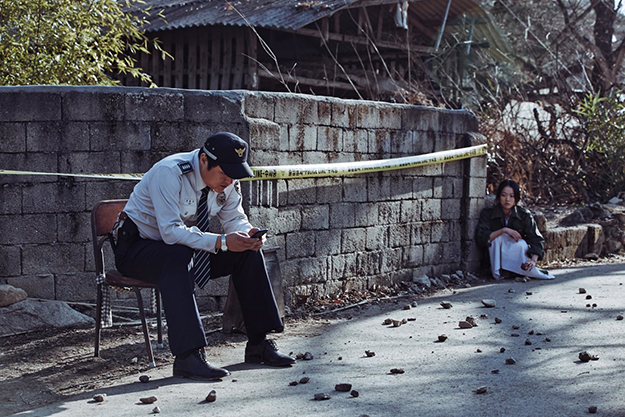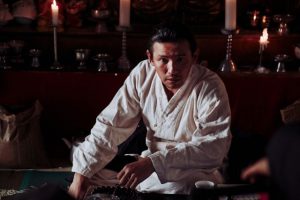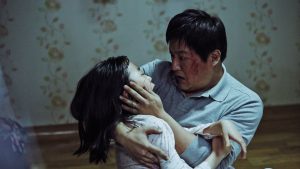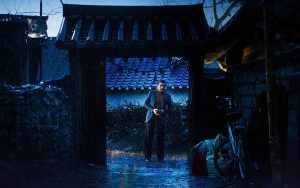 Title: The Wailing | Rated: Not Rated | Runtime: 156 min | Theaters limited (expanding)
Title: The Wailing | Rated: Not Rated | Runtime: 156 min | Theaters limited (expanding)
If you want to explore world cinema, I cannot recommend South Korean films enough. Being Korean myself, I admit my bias, but there’s no denying that this nation’s film industry has progressed in leaps and bounds since the turn of the century. Auteurs like Bong Joon-ho, Kim Jee-woon, and Park Chan-wook have gifted cinephiles with pictures that are as exquisite as they are twisted, and as moving as they are weird. Filmmaker Na Hong-jin, who made a big splash eight years ago with his thrilling tale The Chaser, now joins their ranks. His 2010 follow-up, The Yellow Sea, is decent if not emotionally distant and forgettable, though it does offer glimpses of his storytelling sensibilities and vision. However, it’s his latest feature, The Wailing, that firmly cements Na among the great modern Korean auteurs; he’s at the top of his game here, mastering tone to craft an engrossing story, and he comes close to making his best film to date.
 In the mountainous county of Gokseong, a series of brutal deaths mystify local policeman Jong-goo (Kwak Do-won) and drive the villagers into hysteria. Something is causing individuals to kill others around them for no reason. The police report points to poisonous wild mushrooms as the culprit, but some locals suspect that a mysterious and seemingly supernatural Japanese stranger (Jun Kunimura) is behind these murders. While on duty, Jong-goo encounters a peculiar woman (Chun Woo-hee), who claims she saw the Japanese man at the scene of a crime. Jong-goo’s worries only compound further when his daughter Hyo-jin (Kim Hwan-hee) exhibits the same symptoms that the crazed villagers did before their bloodthirsty sprees. Now starting to believe that demonic possession is involved, Jong-goo agrees to consult a shaman (Hwang Jung-min) in order to find answers and save Hyo-jin before she too goes mad.
In the mountainous county of Gokseong, a series of brutal deaths mystify local policeman Jong-goo (Kwak Do-won) and drive the villagers into hysteria. Something is causing individuals to kill others around them for no reason. The police report points to poisonous wild mushrooms as the culprit, but some locals suspect that a mysterious and seemingly supernatural Japanese stranger (Jun Kunimura) is behind these murders. While on duty, Jong-goo encounters a peculiar woman (Chun Woo-hee), who claims she saw the Japanese man at the scene of a crime. Jong-goo’s worries only compound further when his daughter Hyo-jin (Kim Hwan-hee) exhibits the same symptoms that the crazed villagers did before their bloodthirsty sprees. Now starting to believe that demonic possession is involved, Jong-goo agrees to consult a shaman (Hwang Jung-min) in order to find answers and save Hyo-jin before she too goes mad.
 The sheer audacity and scope of Na’s film warrants admiration, and for the most part, the filmmaker pulls it off spectacularly. From the first frame to the last, the film emanates evil and unease, and it’s incredible how Na gets so much mileage out of this steady atmosphere. He also keeps the proceedings tense by playing upon the question of what faith really entails in addition to Korean anti-Japanese sentiments which stretch back hundreds of years. Grounding all this are compelling characters who have plenty of room to breathe. The film deftly finds their humanity, allowing them to punctuate the mood with humor and power an emotionally charged story. Complementing the characters is the film’s setting – Na wastes no time in establishing his world, and the mysterious, terrifying nature of Gokseong soon draws the audience in. From there, the viewer is hooked, and the film takes off in whatever direction Na points toward. The Wailing isn’t bound to a single genre, and it dabbles in many, from mystery to horror to black comedy to several others. The film gets delightfully zany, and it soars once it reaches the exorcism sequence, which is refreshing to see since it involves shamanism and not the typical Christianity that we commonly see in American and European films featuring such sequences. The first two hours of the film are very strong, and I was convinced that this would be Na’s masterpiece. Then a number of twists in the climax results in a befuddling and intentionally ambiguous ending, which doesn’t quite narratively make sense. Perhaps it would have benefited Na had he been more focused when communicating his ideas there.
The sheer audacity and scope of Na’s film warrants admiration, and for the most part, the filmmaker pulls it off spectacularly. From the first frame to the last, the film emanates evil and unease, and it’s incredible how Na gets so much mileage out of this steady atmosphere. He also keeps the proceedings tense by playing upon the question of what faith really entails in addition to Korean anti-Japanese sentiments which stretch back hundreds of years. Grounding all this are compelling characters who have plenty of room to breathe. The film deftly finds their humanity, allowing them to punctuate the mood with humor and power an emotionally charged story. Complementing the characters is the film’s setting – Na wastes no time in establishing his world, and the mysterious, terrifying nature of Gokseong soon draws the audience in. From there, the viewer is hooked, and the film takes off in whatever direction Na points toward. The Wailing isn’t bound to a single genre, and it dabbles in many, from mystery to horror to black comedy to several others. The film gets delightfully zany, and it soars once it reaches the exorcism sequence, which is refreshing to see since it involves shamanism and not the typical Christianity that we commonly see in American and European films featuring such sequences. The first two hours of the film are very strong, and I was convinced that this would be Na’s masterpiece. Then a number of twists in the climax results in a befuddling and intentionally ambiguous ending, which doesn’t quite narratively make sense. Perhaps it would have benefited Na had he been more focused when communicating his ideas there.
 Headlining the picture is a one hell of an effective cast, who eat up every minute and opportunity to allow the characters to breathe. Kwak does fantastic work here, and it’s easy to emotionally invest in his character because of the performance. His oafishness and deprecating sense of humor make him utterly endearing, and he nails every dramatic beat, effortlessly expressing fury and terror. Hwang is appropriately charismatic and flamboyant as the shaman, and to see him put forth a full body performance during the exorcism sequence makes for one intense experience. Enhancing the film’s unsettling tone is Kunimura, who brings an eerie, feral quality that constantly but slowly escalates. Though the film doesn’t feature her as much as one expects, Chun always works to build up the aura of mystery that her character exudes. Out of the entire cast, Kim is the most memorable. It’s a fiercely committed turn from her, and she takes advantage of the fact that the demon inside Hyo-jin speaks using her voice, so her whole performance begs the question of who really is speaking when Hyo-jin opens her mouth.
Headlining the picture is a one hell of an effective cast, who eat up every minute and opportunity to allow the characters to breathe. Kwak does fantastic work here, and it’s easy to emotionally invest in his character because of the performance. His oafishness and deprecating sense of humor make him utterly endearing, and he nails every dramatic beat, effortlessly expressing fury and terror. Hwang is appropriately charismatic and flamboyant as the shaman, and to see him put forth a full body performance during the exorcism sequence makes for one intense experience. Enhancing the film’s unsettling tone is Kunimura, who brings an eerie, feral quality that constantly but slowly escalates. Though the film doesn’t feature her as much as one expects, Chun always works to build up the aura of mystery that her character exudes. Out of the entire cast, Kim is the most memorable. It’s a fiercely committed turn from her, and she takes advantage of the fact that the demon inside Hyo-jin speaks using her voice, so her whole performance begs the question of who really is speaking when Hyo-jin opens her mouth.
 Na is working at what may be his peak here, and it shows in the film’s excellent craft. Any runtime over two-and-a-half hours is gargantuan, but editor Kim Sun-min ensures that the film breezes along and also showcases a brilliance at cross-cutting action, as evidenced by the film’s centerpiece exorcism sequence, in which dueling rituals are played out simultaneously. Veteran cinematographer Hong Kyung-pyo captures the peaceful and gorgeous countryside with a calm and steady hand, just as he does with creepy objects such as a tattered notebook and a dead crow. The fact that the film was mostly shot with natural light complements the film’s atmosphere, as anything shrouded in shadow immediately induces goosebumps. Lee Hwo-kyung’s production design aims for a weathered feel, imparting a sense of reality that adds to the general unease. The use of Korean traditional instruments in Jang Young-gyu’s score may come across as cacophonous, but the beating and clanging dramatically augment the feeling of dread. Ditto to the terrific sound design and mixing, which stretch tension all the more and make the few jump scares frightening.
Na is working at what may be his peak here, and it shows in the film’s excellent craft. Any runtime over two-and-a-half hours is gargantuan, but editor Kim Sun-min ensures that the film breezes along and also showcases a brilliance at cross-cutting action, as evidenced by the film’s centerpiece exorcism sequence, in which dueling rituals are played out simultaneously. Veteran cinematographer Hong Kyung-pyo captures the peaceful and gorgeous countryside with a calm and steady hand, just as he does with creepy objects such as a tattered notebook and a dead crow. The fact that the film was mostly shot with natural light complements the film’s atmosphere, as anything shrouded in shadow immediately induces goosebumps. Lee Hwo-kyung’s production design aims for a weathered feel, imparting a sense of reality that adds to the general unease. The use of Korean traditional instruments in Jang Young-gyu’s score may come across as cacophonous, but the beating and clanging dramatically augment the feeling of dread. Ditto to the terrific sound design and mixing, which stretch tension all the more and make the few jump scares frightening.
Bold and operatic, The Wailing is a tremendous film, probably one of the best Korean films in recent memory. Raising as many questions as thoughts, the picture demands rewatch so that you can piece the characters, ideas, and themes together. Even if you’re not willing to do that, it stays with you, and that’s the mark of an incredibly crafted film. I can’t stop thinking about it.
Rating: 4.5/5.0
* Photos courtesy of Well Go USA Entertainment
